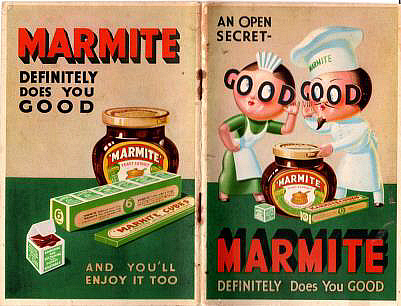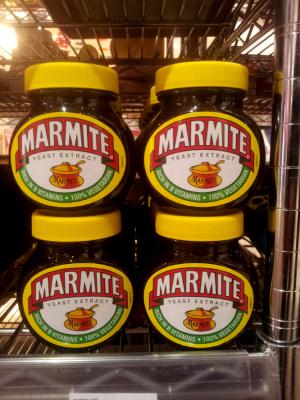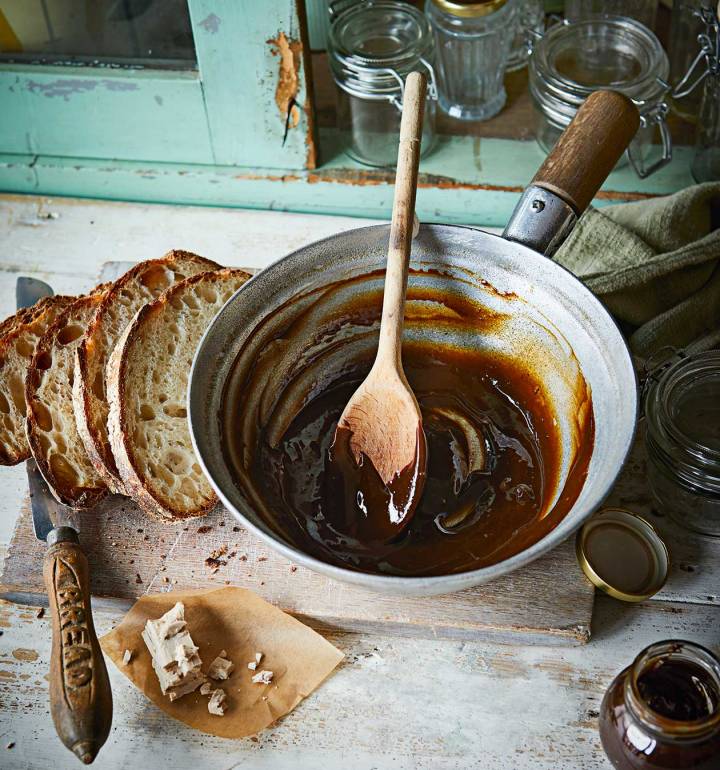

|
 Trade name for a savoury spread made from yeast extract, salt, vegetable extracts, vitamins, and celery extract. Usually served spread very thinly on toast.  The precise receipt and method of manufacture remain secret, but it is thought to be derived from waste brewery yeast mixed with salt so as to break down the cell walls and then concentrated using the process pioneered by the German chemist Justus von Liebig (1803-1873), the ‘Father of Artificial Fertilizer’. The Marmite Food Extract Company was formed in Burton upon Trent, a major brewing centre, in 1902, and is now owned by Unilever. In 1999 Edward De Bono, the celebrated master of lateral thinking, suggested to the UK foreign office that Marmite might be the answer to the seemingly intractable problems of the Middle East. There, he reasoned, they tend to eat unleavened bread and so miss out on the zinc found in yeast, and a lack of zinc makes men irritable and belligerent. Marmite is high in zinc, hence it is a way to peace. There is a long-standing, and quite uncorroborated, opinion that eating Marmite can ward off mosquitoes. Bill Bryson, in ‘Notes from a Small Island‘ described Marmite as “an edible yeast extract with the visual properties of an industrial lubricant…” Yeast extract spreads seem to have a curious nationalism. Britain clings to ‘Marmite’ and Australia to ‘Vegemite’ so parts of Germany and Poland have ‘Vitam-R’, the French-Speaking part of Switzerland has ‘Cenovis’ and ‘Brazil’ has ‘Cenovit’, but to the rest of the world these yeast pastes are more-or-less unknown.  This, we cannot vouch for…  Original Receipt from ‘Sainsbury’s Magazine‘ Original Receipt from ‘Sainsbury’s Magazine‘Make-your-own ‘Marmite’ Recipe by Alex Bond  This version of Marmite is so versatile; you can slather it on toast, use it to flavour broths and gravy, and even toss your roast potatoes in it Makes: 1 x 200ml jar Prep time: 30 mins Total time: 3 hrs 30 mins Ingredients 1kg sourdough bread, thickly sliced 7g fresh yeast, or brewer’s yeast powder 10g sugar (any type) Step by step Keeps for up to 1 month in a sterilised jar in the fridge. Preheat the oven to 220°C, fan 200°C, gas 7. Put the sliced bread on a large baking tray and toast in the oven for 25-30 minutes, turning halfway, until very well browned. Chop into large cubes. Combine the yeast and sugar with a little water in a very large bowl, then pour in a further 4 litres of room-temperature water. Stir in the toasted bread and leave to soak, covered with a clean tea towel or muslin, for 12 hours. After 12 hours, use a slotted spoon to scoop out a bit of the bread at a time. Holding it over the bowl, squeeze the liquid that it has soaked up back into the bowl, then discard the squeezed-out bread. Repeat with all the bread until you’re left with just a cloudy liquid. Loosely cover with a clean tea towel or muslin and leave the liquid to ferment at room temperature for the next 2 days. Pour the liquid into a large wide pan on thehob and reduce to a syrupy consistency (it will thicken further as it cools). As the 4 litres of liquid will reduce to about 200ml of ‘Marmite’, it may take a couple of hours to reduce to the right consistency – you’ll need to keep an eye on it towards the end of the reduction time to make sure it doesn’t catch, and you may want to transfer it to a smaller pan towards the end. Chef quote This recipe is super-rich, with a really strong umami flavour. It’s a bit less salty and more acidic than shop-bought Marmite, which is made from leftover brewer’s yeast. I think that’s what gives ours a deeper, richer, more ‘bready’ flavour.  |
|
MORE FROM Foods of England... Cookbooks ● Diary ● Index ● Magic Menu ● Random ● Really English? ● Timeline ● Donate ● Royalty ● English Service ● Food Map of England ● Lost Foods ● Accompaniments ● Biscuits ● Breads ● Cakes and Scones ● Cheeses ● Classic Meals ● Curry Dishes ● Dairy ● Drinks ● Egg Dishes ● Fish ● Fruit ● Fruits & Vegetables ● Game & Offal ● Meat & Meat Dishes ● Pastries and Pies ● Pot Meals ● Poultry ● Preserves & Jams ● Puddings & Sweets ● Sauces and Spicery ● Sausages ● Scones ● Soups ● Sweets and Toffee ● About ... ● Bookshop ● Email: [email protected] COPYRIGHT and ALL RIGHTS RESERVED: © Glyn Hughes 2022 BUILT WITH WHIMBERRY |